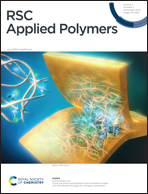Tough tetrazine-functionalized styrene–butadiene rubber with self-adhesion through zinc–nitrogen coordination†
Abstract
We report a feasible system for the direct adhesion of cross-linked rubbers, based on incorporating tetrazine ligands into a styrene–butadiene rubber (SBR) followed by the addition of zinc dimethacrylate (ZDMA) with the aim of forming reversible coordination cross-links. The modification of SBR is achieved using an inverse-electron-demand Diels–Alder (IEDDA) click reaction with 3,6-di(2-pyridyl)-1,2,4,5-tetrazine (DPT) during the rubber-kneading process. The complexation capability of the bound DPT in the SBR with ZDMA is demonstrated using a small model molecule including a DPT unit via UV-vis spectra. The obtained DPT–ZDMA cross-linked rubbers show unique temperature dependence in dynamic mechanical analysis (DMA), demonstrating the dissociation and reassociation of the DPT–ZDMA cross-linking. Strain-sweep DMA tests exhibited a typical Payne effect with increasing amount of bound DPT units in the SBR, supporting the formation of ZDMA–ZDMA filler interactions. Furthermore, the reversible nature of DPT–ZDMA cross-linking endows the resulting composites with high strength. A tensile strength of up to 30.5 MPa at 579% elongation was achieved when 2.6 mol% of DPT was incorporated into SBR with 40 phr of ZDMA. Hysteresis measurements revealed that the amount of bound DPT in the SBR and the ZDMA content significantly impact the hysteresis loss due to the dissociation of the DPT–ZDMA cross-linking and ZDMA–ZDMA filler interactions, leading to high energy dissipation and high toughness. Finally, a direct adhesion application was demonstrated using T-peel tests, where the adhesion-peeling force reaches up to 5.72 N mm−1 when 2.6 mol% of DPT was incorporated into SBR with 60 phr of ZDMA. The maximum peeling force showed a good correlation with the difference between the E′ value at 25 °C and that at 145 °C as obtained from the DMA tests, clearly demonstrating that the degree of DPT–ZDMA cross-linking is a main factor in determining the adhesion strength in the DPT–ZDMA cross-linking system.

- This article is part of the themed collection: Editor’s Choice - Pengfei Cao


 Please wait while we load your content...
Please wait while we load your content...